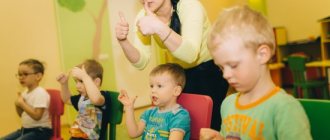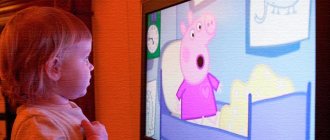Hearing impairment of varying severity is diagnosed in 0.1-0.3% of newborns. Negative factors can damage the structures of the ear and the baby’s brain during pregnancy, during childbirth or after birth. The likelihood of deafness or hearing loss is higher in children who were born prematurely or spent a long time in the intensive care unit. Newborn hearing testing is carried out in the first few days of life and allows you to assess whether the child needs help or supervision from an otolaryngologist.
Varieties of humming
In pediatrics and speech therapy, it is customary to distinguish two types of humming:
- hooting (is the initial stage of hooting, when the baby begins to pronounce short monosyllabic structures);
- pipe (the second stage of development of humming, in which the ability to stretch several syllables in a cascade appears; develops by the 4th month of life).
There is no interethnic or international distinction in humming - children from any linguistic and ethnic background hum the same. Only at the final stage of development of this type of communication (closer to six months of life) can features characteristic of a particular people appear in pronunciation.
Buzzing is also typical for children who are hard of hearing or deaf.
When children start to roar
Often parents do not notice changes in the baby’s pronunciation, missing the moment when the child develops the ability to pronounce individual vowel sounds. Then their speech may seem bizarre and unusual, since the sounds have an extended structure.
Such changes are noticeable already in the second or third month of life. At this age, the first communication skills are formed, when the child tries to communicate through the pronunciation of syllables, as well as simple sound structures. Pronouncing whole words is not typical.
The period of cooing lasts from 2 to 4 months, after which the baby begins to babble and learn to pronounce individual syllables, even words. By the third or fourth month of life, the baby can walk constantly, even for several hours a day without breaks. You can read more in detail in our article - when a child begins to gurgle and coo.
The structure of the cooing changes over time - at first it can be solo fragmentary sounds, which later become smoother, melodic and continuous.
In addition to vowels, when a child gurgles, he can learn to say long consonants like “m”, “s”, as well as the letters “b”, “p”. This makes speech more varied.
How parents can help with boozing
Humming and babbling can be seen as ways of finding new ways to communicate. Parents should take this into account and support the baby by talking to him. This can be done like this:
- always respond to the sounds that the baby makes, encourage him;
- treat speech kindly - smile, show that the child is doing everything right, that his actions are pleasant to the parents;
- actively articulate when communicating;
- use gestural techniques to make speech more expressive; Sometimes you can also make a face to maintain interest;
- communicate actively and clearly.
It is also necessary to ensure that the process of speech development occurs in a calm environment, when there are no unpleasant or distracting factors.
Usually, a baby does not begin to coo in order to inform the parent about his needs or desires. Walking is perceived as a game, so in order for speech learning to be effective, you need to create favorable conditions for this - the baby must be clean, healthy and well-fed.
What can you do if there is no partying?
There is no need to worry if the baby has not started to walk by the age of 2 months - with normal development, the process of learning the structure of speech is individual, so for some it can happen very quickly, while for others it happens late. Temperament matters - some children start playing very early, while others remain silent for no apparent reason.
You should consult a specialist if your child cannot walk at all by the age of 4 months. In such a situation, the pronunciation of fragmentary or smooth vowel sounds is completely absent. Then some developmental disorders are likely.
There is an opinion that walking can be taught through simple tasks and exercises, when silence is not caused by failures or deviations in intellectual and physical growth. Lack of cooing may be due to lack of communication. To begin with, the mother should talk to the baby more often, sing him calm children's songs and lullabies. When singing, it is advisable to draw out vowel sounds so that they can be heard and remembered.
It is necessary to create the right environment in the family - to ensure peace and well-being. Under no circumstances should you quarrel near a child, as this can ruin the child’s mood and affect the development of his communication skills. Learning sounds begins during play, and if the surrounding environment is unfavorable, the baby will not be able to do this. If relationships within the family improve, the child will quickly learn to walk.
Some doctors and parents recommend starting to develop fine motor skills as early as two or three months of age. Speech skills may depend on the degree of physical development, so you should pay attention to touching the baby’s hands and feet. You can also give him small objects to hold.
It is important not to yell at a child for misbehavior or force him to talk loudly, as this has the opposite effect - due to fear of parents, speech skills do not develop.
It is necessary to pay attention to the intonation of communication and correct it, since by the third month children are able to distinguish shades of mood and grasp the tone of the conversation. If the baby's babbling has begun, it will smoothly move into the babbling stage, in which syllables and simple words are formed.
Useful video about speech development in a child
List of sources:
- Sapozhnikov Ya. M., Cherkasova E. L., Minasyan V. S., Mkhitaryan A. S. Speech disorders in children. Pediatrics. Journal named after G. N. Speransky. 2013; 92(4):82–87.
- Asmolova G. A., Zavadenko A. N., Zavadenko N. N., Kozlova E. V., Medvedev M. I., Rogatkin S. O., Volodin N. N., Shklovsky V. M. Early diagnosis of disorders speech development. Features of speech development in children with consequences of perinatal pathology of the nervous system. Guidelines. M.: Union of Pediatricians of Russia, Russian Association of Perinatal Medicine Specialists. 2014. 76 p.
- Arkhipova E.F. Speech therapy work with young children. M., 2007.
- Gromova O.E. Methodology for forming the initial children's vocabulary. M., 2005.
Author
Oksana Belokur
Pediatrician
Share
How can you develop your walking skills?
If your baby's humming is not too pronounced, you can try to speed up the development of the skill. To do this you should:
- talk to the baby not too loudly so as not to frighten him, and not too quietly so that what is said can be clearly heard;
- maintain a friendly tone of communication;
- do not weaken contact with the child at the visual level - it is important that the position of the adult’s lips and the manner of pronouncing the sound are visible (in some cases, children deliberately try to see this);
- maintain silence in the room, as extraneous noise can stop the noise and make you fall silent;
- play simple games like “ladki”;
- copy the child's manner of pronunciation - cooing and cooing in response, since the imitation reflex does not fade away at the age of six months (sometimes this is a method of therapy - children are played a hum recorded on a voice recorder to show them the correct model of speech development);
- gently massage the child’s cheeks, lips, belly and chest, while you can recite a children’s poem or sing a song - this helps develop children’s vocal delivery (it occurs suddenly);
- Praise the baby for his success in communication, support his activity.
You cannot distort words and lisp with children - incorrect pronunciation by parents causes incorrect reproduction of sounds when humming, and in the future - syllables and words.
Table of normative data on the development of certain communication skills by children.
Items were selected from three scales—the parent questionnaires KID scale, CDI, and McArtur CDI. For each item, the age in months is indicated by which 50% of children and 85% of children master this skill (and in the case of CDI, the results are given for boys and for girls). Data are based on 670 children for the KID, 2200 children for the CDI, and 1160 children for the McArtur CDI.
The given items from these scales cannot give a complete picture of the child's development. They can show parents when to expect their child to master a particular skill.
Table of normative data for mastering some communication skills:
Communication
| KID scale | 50% | 85% |
| Makes sounds when spoken to | >2 | 3 |
| Uses voice to express emotions (not just crying) | 2 | 3 |
| Tries to attract the attention of an adult with babble and smiles | 2 | 5 |
| Gets excited (happy when an adult picks him up) | 3 | 4 |
| Recognizes most familiar adults | 3 | 4 |
| Reacts differently to strangers and acquaintances | 3 | 6 |
| Smiles if an adult makes a funny face | 4 | 8 |
| Reaching out to a familiar person | 4 | 7 |
| Laughs loudly when tickled | 5 | 7 |
| Laughs if an adult makes a funny face | 5 | 9 |
| Tries to attract the attention of an adult by reaching out to him and holding out his hands | 5 | 9 |
| Reacts to a game of hide and seek (“peek-a-boo”) | 6 | 9 |
| Imitates “ma-ma” or “da-da” | 7 | 9 |
| Likes to drop toys and have an adult pick them up | 7 | 9 |
| Cries when a toy is taken away | 7 | 11 |
| Whines or cries when scolded | 8 | 13 |
| Resists when an adult or child tries to take the toy away | 8 | 11 |
| Hugs mom and shows his love for her | 9 | 12 |
| Claps his hands when asked | 10 | 12 |
| Points to the object that wants | 10 | 12 |
| Tries to repeat words | 12 | >15 |
| Imitates an adult's facial expression | 12 | >15 |
| Shakes his head in denial | 13 | >15 |
| Kisses an adult when asked | 14 | >15 |
| Repeats words when asked | 15 | >15 |
| CDI Scale | 50% Boys | 85% Boys | 50% Girls | 85% Girls |
| Asks for food or drink using words or sounds | < 15 | 15 | 15 | < 15 |
| Does familiar things “for fun, for example, “talking on the phone”” | < 15 | 20 | < 15 | 19 |
| Usually shares toys or other things | < 15 | 27 | < 15 | 21 |
| Asks for help when doing something | 16 | 23 | 15 | 23 |
| Plays with other children, does things with them | 16 | 33 | 16 | 29 |
| Sometimes he says “no” when pestered | 19 | 29 | 17 | 25 |
| Sympathizes with other children, tries to help and comfort them | 23 | 40 | 19 | 33 |
| Expresses complaints in words | 26 | 40 | 22 | 33 |
| Greetings by saying "hello" or something similar | 27 | 40 | 24 | 39 |
Speech understanding
| KID scale | 50% | 85% |
| Recognizes mother's voice | 2 | 5 |
| Quickly turns his head towards a familiar voice | 3 | 6 |
| Reacts when hearing his name | 4 | 6 |
| Turns around when he hears his name | 4 | 7 |
| Reacts to “come to me” by raising his arms | 6 | 8 |
| Stops when he hears his name | 7 | 9 |
| Stops when you scream "no" | 8 | 10 |
| Stops when you say "no" | 9 | 11 |
| Follows simple directions, such as “come to me” | 9 | 12 |
| Recognizes the names of familiar objects | 9 | 12 |
| Understands “bye-bye” (“goodbye”) | 10 | 12 |
| CDI Scale | 50% Boys | 85% Boys | 50% Girls | 85% Girls |
| When asked, shows at least three body parts such as nose, mouth, arms or legs | < 15 | 17 | 15 | < 15 |
| Understands what “open” and “close” means; follows directions with these words | < 15 | 15 | < 15 | 15 |
| Follows two-part instructions, for example: “go to your room and bring me...” | 15 | 20 | < 15 | 18 |
| Understands what “on” and “with” mean; follows directions with these words | 15 | 20 | < 15 | 18 |
| Understands the meaning of at least three words that indicate the position of objects, such as “in”, “on”, “under”, “at”, “near” | 18 | 27 | 16 | 25 |
| Understands what “up” and “down” mean | 18 | 28 | 17 | 25 |
| Answers correctly “yes” or “no” to simple questions | 21 | 29 | 19 | 26 |
| Understands what “one” is and gives exactly one item when asked for “one” | 21 | 29 | 20 | 27 |
| Understands what “everything” is: if asked to give all the pencils, he really gives everything | 21 | 30 | 20 | 27 |
| Correctly identifies at least one color by name | 21 | 34 | 21 | 29 |
| Shows or names the larger of two objects when asked | 23 | 36 | 23 | 33 |
Vocalizations
| KID scale | 50% | 85% |
| Makes at least two different sounds | > 3 | > 3 |
| "Speaks" in his own language ("booms") | > 3 | > 3 |
| Makes sounds that are loud and quiet | > 3 | 4 |
| Repeats the same sounds over and over again | 3 | 5 |
| Laughs | 3 | 6 |
| Squeals | 4 | 8 |
| Pronounces sounds similar to “ma-ma”, “ba-ba”, “la-la” | 6 | 9 |
| Makes "mmm" or "sss" sounds | 6 | 10 |
| Imitates “ma-ma” or “da-da” | 7 | 10 |
| Imitates coughing, mooing, clattering, and other sounds | 8 | 12 |
Gestures (not all gestures are created equal)
| McArthur CDI | 50% | 85% |
| Raises his arms when he wants to be held | 6 | 9 |
| Extends his hand to show what he is holding in his hand | 10 | 11 |
| Reaches out his hand and gives you the object he is holding in his hand | 10 | 11 |
| Points (with hand or finger) to something interesting | 10 | 12 |
| Demands to give him something, extending his hand and making a grasping gesture (opening and closing his palm) | 10 | 22 |
| When someone leaves, he waves his hand - “goodbye” | 11 | 17 |
| Smacks lips to indicate “delicious” | 14 | |
| Shakes his head to mean "no" | 14 | 21 |
| Nods his head to mean "yes" | 17 | |
| Shrugs to show: “no more”, “finished” or “disappeared” | 17 | |
| Blows kisses | 20 |
Dictionary
| KID scale | 50% | 85% |
| Speaks one word clearly | 10 | >15 |
| Calls mom “ma-ma” (meaningfully) | 11 | >15 |
| 13 | >15 |
| CDI scale | 50% Boys | 85% Boys | 50% girls | 85% Girls |
| Says at least two words other than “mama” and “dada” | < 15 | 21 | < 15 | 18 |
| Answers questions like: “what does the dog say?” ... pussy? ...duck?" | 16 | 25 | < 15 | 21 |
| Uses at least five different words (not necessarily adult-sounding ones) to refer to different things | 17 | 30 | 16 | 32 |
| Uses at least 10 words | 21 | 31 | 17 | 26 |
| Names several familiar objects in picture books | 19 | 29 | 17 | 25 |
| If you don’t like the subject, he says “bad”, “kaka”, etc. about it. | 21 | 31 | 19 | 28 |
| Says his name, at least when asked: “What is your name? » | 26 | 39 | 20 | 28 |
| Uses the negation “not” in the expressions: “don’t”, “can’t”, “won’t”, etc. | 25 | 36 | 22 | 31 |
| When asked, names at least five body parts, such as eyes, nose, mouth, arms, legs | 27 | 37 | 22 | 33 |
| Tells what action is shown in the picture: for example, “The cat is eating” | 27 | 27 | 37 | 23 |
| Uses at least 20 words | 25 | 40 | 23 | 30 |
| Says about his things “mine”, or “mine”, or “mine” | 28 | 38 | 23 | 32 |
| Uses sentences of two, three or more words | 26 | 36 | 23 | 29 |
| Uses the words “big” and “small” | 27 | 37 | 23 | 32 |
| Uses at least one of the following words: “I”, “you”, “she”, “it”, “me”, “me” | 26 | 36 | 24 | 30 |
What to do if your child stops walking
The sudden cessation of humming, if it has not turned into babbling, should cause concern among parents. It is better to show the baby to a specialist in such a situation to exclude the possibility of developmental deviations. This is especially true if the baby not only stopped walking, but also became lethargic and restless.
Parents can help on their own by continuing to talk to the child (expressively, emotionally, actively), copying the sounds of humming and hooting even if the baby no longer voluntarily pronounces them. You must always maintain a favorable psychological environment around the baby. This helps if the condition is not caused by intellectual or physical impairments.
Every parent of a baby should know what humming is, since this is an important process in the development of children's speech, during which the process of learning the correct pronunciation of individual vowels and sometimes consonant sounds occurs. Appears at the age of 2-3 months. You should consult a specialist if the child is lethargic, sad, has suddenly stopped humming, or was initially absent by the age of 7 months. But if the baby is cheerful, cheerful, and also active, it is most likely that the humming has not yet begun due to individual developmental characteristics.
Babbling
This is the stage of pre-speech development following humming, which precedes the appearance of new words and phrases.
What does it sound like
The child constantly practices the acquired skill of humming, beginning syllables with labial sounds - “b”, “m”, “p”. He gets “ba, ma,” “pa,” “ta.” He babbles to himself when he is busy playing, exploring his own capabilities. Sometimes uses babble to attract parents' attention.
When does it start
The baby starts babbling at 4–5 months, cooing syllables at 6–7 months, and at 8.5–9 months he repeats the intonation and sounds of adults. Closer to one year, the baby speaks its first words.
It is from babbling that words are born.








